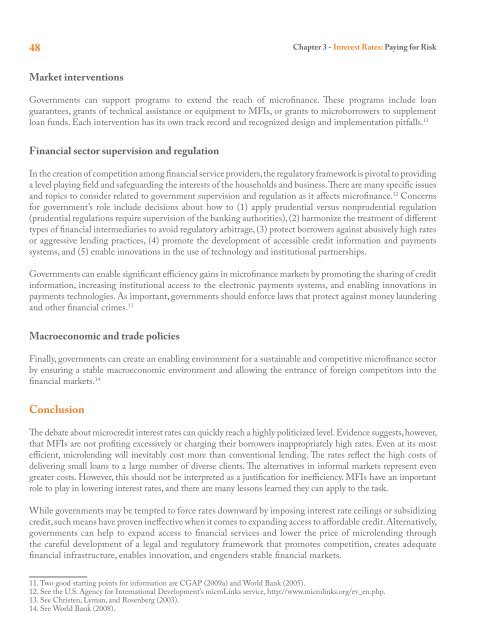managing risk.pdf
managing risk.pdf
managing risk.pdf
You also want an ePaper? Increase the reach of your titles
YUMPU automatically turns print PDFs into web optimized ePapers that Google loves.
48 Chapter 3 - Interest Rates: Paying for RiskMarket interventionsGovernments can support programs to extend the reach of microfinance. These programs include loanguarantees, grants of technical assistance or equipment to MFIs, or grants to microborrowers to supplementloan funds. Each intervention has its own track record and recognized design and implementation pitfalls. 11Financial sector supervision and regulationIn the creation of competition among financial service providers, the regulatory framework is pivotal to providinga level playing field and safeguarding the interests of the households and business. There are many specific issuesand topics to consider related to government supervision and regulation as it affects microfinance. 12 Concernsfor government’s role include decisions about how to (1) apply prudential versus nonprudential regulation(prudential regulations require supervision of the banking authorities), (2) harmonize the treatment of differenttypes of financial intermediaries to avoid regulatory arbitrage, (3) protect borrowers against abusively high ratesor aggressive lending practices, (4) promote the development of accessible credit information and paymentssystems, and (5) enable innovations in the use of technology and institutional partnerships.Governments can enable significant efficiency gains in microfinance markets by promoting the sharing of creditinformation, increasing institutional access to the electronic payments systems, and enabling innovations inpayments technologies. As important, governments should enforce laws that protect against money launderingand other financial crimes. 13Macroeconomic and trade policiesFinally, governments can create an enabling environment for a sustainable and competitive microfinance sectorby ensuring a stable macroeconomic environment and allowing the entrance of foreign competitors into thefinancial markets. 14ConclusionThe debate about microcredit interest rates can quickly reach a highly politicized level. Evidence suggests, however,that MFIs are not profiting excessively or charging their borrowers inappropriately high rates. Even at its mostefficient, microlending will inevitably cost more than conventional lending. The rates reflect the high costs ofdelivering small loans to a large number of diverse clients. The alternatives in informal markets represent evengreater costs. However, this should not be interpreted as a justification for inefficiency. MFIs have an importantrole to play in lowering interest rates, and there are many lessons learned they can apply to the task.While governments may be tempted to force rates downward by imposing interest rate ceilings or subsidizingcredit, such means have proven ineffective when it comes to expanding access to affordable credit. Alternatively,governments can help to expand access to financial services and lower the price of microlending throughthe careful development of a legal and regulatory framework that promotes competition, creates adequatefinancial infrastructure, enables innovation, and engenders stable financial markets.11. Two good starting points for information are CGAP (2009a) and World Bank (2005).12. See the U.S. Agency for International Development’s microLinks service, http://www.microlinks.org/ev_en.php.13. See Christen, Lyman, and Rosenberg (2003).14. See World Bank (2008).
















